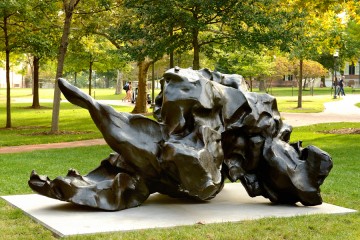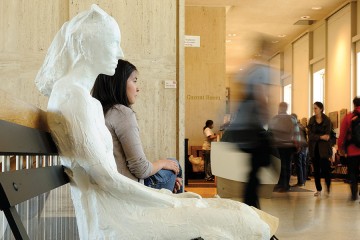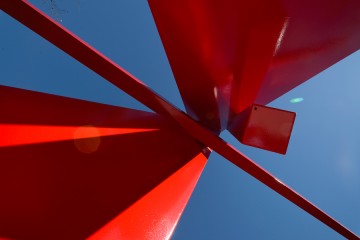If you've ever stopped on the Homewood campus to marvel at the beauty of a painting or to contemplate the perfect proportions of a sculpture, you aren't alone.
With JHU's collection of approximately 3,500 pieces of art and other cultural artifacts, up to 200 of which are on display at any given time, chances are you've encountered (and maybe even given more than passing thought to) a photograph, sculpture, mural—or perhaps even a piece of furniture or historic scientific equipment—in your travels around the campus. What you might not have considered is just how much effort goes into acquiring and displaying such works—and why.
JHU has long held and displayed such works, but in recent years the acquisition and placement of these pieces has increasingly been approached with a deliberate end in mind: to ensure JHU's public works of art are accessible to all for enjoyment and learning, says Jackie O'Regan, curator of cultural properties. Not only that, but since 2013 O'Regan's office has used funding from the Office of the President to help augment the university's public art collection by purchasing and displaying the works of artists from Baltimore or the region, or who have an affiliation with colleague institutions such as MICA.
"So when we purchase or acquire works, we're looking to give recognition to those artists and also to make sure that students have an opportunity to take part in presenting and interpreting the art," O'Regan says. Often that has meant pairing student curators with artists to create an exhibit. It might also mean considering ways the works can be used for educating students and faculty, by incorporating them into a class or project, for example.
While there are many offerings to choose from, these are three great ways to see the fruits of the university's efforts:
The public art audio tour
New this fall is an easy-to-use audio tour of 11 sculptures and murals on the Homewood campus. The student-generated project was the work of Triaje Eaddy, a Bloomberg Arts and Culture intern—a public high school student paired with an arts enterprise for a six-week paid internship—and Julia Zimmerman, a Johns Hopkins undergraduate in the Krieger School's Program in Museums and Society.
Together the duo interviewed experts, researched the sculptures, and narrated and created the tour (you can find it here or download the app from the website). The result is a guided walk through works that range from Theodore C. Scuris' Give Peace a Chance, an abstract burnished aluminum sculpture at the southern tip of campus, to Levering Hall's 2,700-square-foot Apocalypse mural, with audio clips from its creator, artist Bob Hieronimus, discussing the historical context of the mural.
Runaways in the library
A gift from JHU alumna Constance Rose Caplan, Runaways, a suite of 10 lithographs by American artist Glenn Ligon, is an example of the university's efforts to promote minority artists and ensure broad access to works of art.
It was Caplan who chose and funded the work and suggested its location, on the heavily trafficked M level of the Milton S. Eisenhower Library, a place where the installation would be highly visible to students. The pieces, which adopt the format of advertisements for escaped slaves and describe Ligon, who is African-American, is designed to provoke thought, O'Regan says. "It challenges the viewer and the reader to think about what is really going on there," she says. "So, again, art on campus is not just about decoration. We really want to be deliberate and thoughtful about what we're buying and acquiring."
While you're at the library, be sure to check out a few other works of art on the M level, including the stunning chromographic print of the university's George Peabody Library by Candida Höfer and the chrome-plated steel sculpture by David Lee Brown, which sits in an outside light well but is visible from the reading room.
A small but mighty sculpture
On display in the Albert D. Hutzler Reading Room in Gilman Hall since this summer, a small African-American sculpture by artist Joyce J. Scott faces a row of portraits of former presidents of the university, her placement chosen by two JHU students who curated the piece for their class, Collections Remix: Black at Hopkins, taught by Jennifer Kingsley, assistant director of the Program in Museums and Society.
The students, Maddy Brancati and Nia Josiah, were deliberate in their placement of the piece, O'Regan says. "The university portraits are all white men, and the figure is female and African-American." The curators worked with Scott to create a display for the piece and wrote in the text: "Scott pushes back against the senselessness of prejudice and all its 'isms' by collecting competing identities of the body." Born in Baltimore, Scott is a graduate of MICA and a 2016 MacArthur Fellow. Regan says that the selection of Scott's sculpture, and the inclusion of two students in preparing it for display, is an important part of her efforts to foster thoughtful dialogue surrounding works by artists from diverse backgrounds.
About the works above
Glenn Ligon (American, b. 1960)
Runaways, 1993
Suite of 10 lithographs, edition 44/45, 10AP
Gift of Constance Rose Caplan
Candida Höfer (German, b. 1944)
George Peabody Library, 2010
Chromogenic print
Gift of Robert Meyerhoff and Rheda Becker
David Lee Brown (American, b. 1939)
Centennial Sculpture, 1975
Chrome-plated steel
Joyce J. Scott (American, b. 1948)
Ancestry Doll 1, 2011
Beads, African sculpture (Ghana), Japanese-made figurines, thread, and fabric
Posted in News+Info, Benefits+Perks
Tagged music + museums + more













